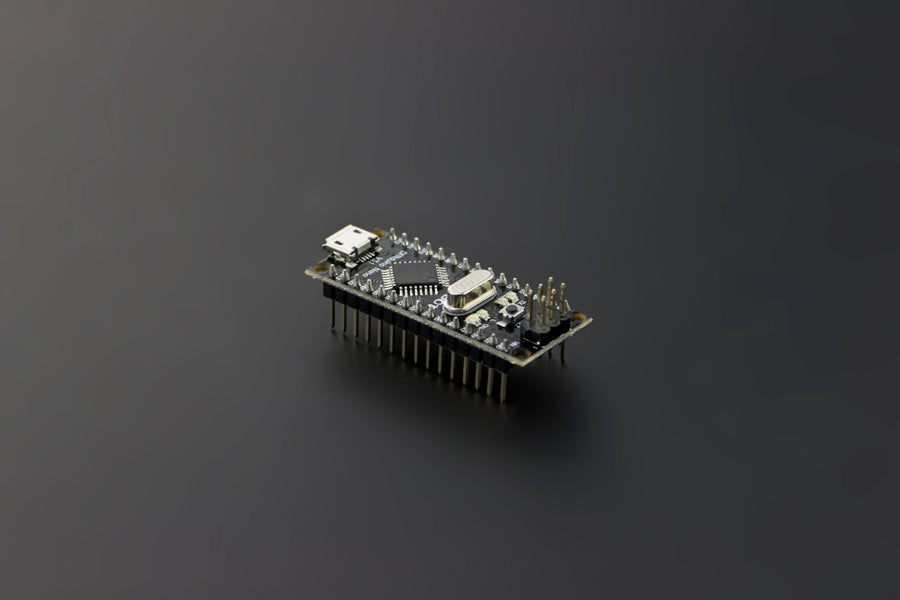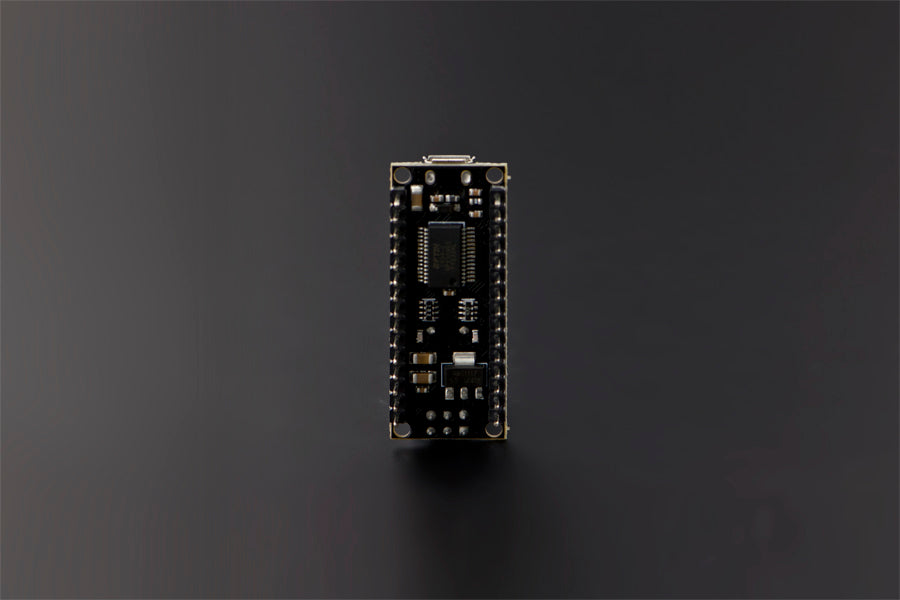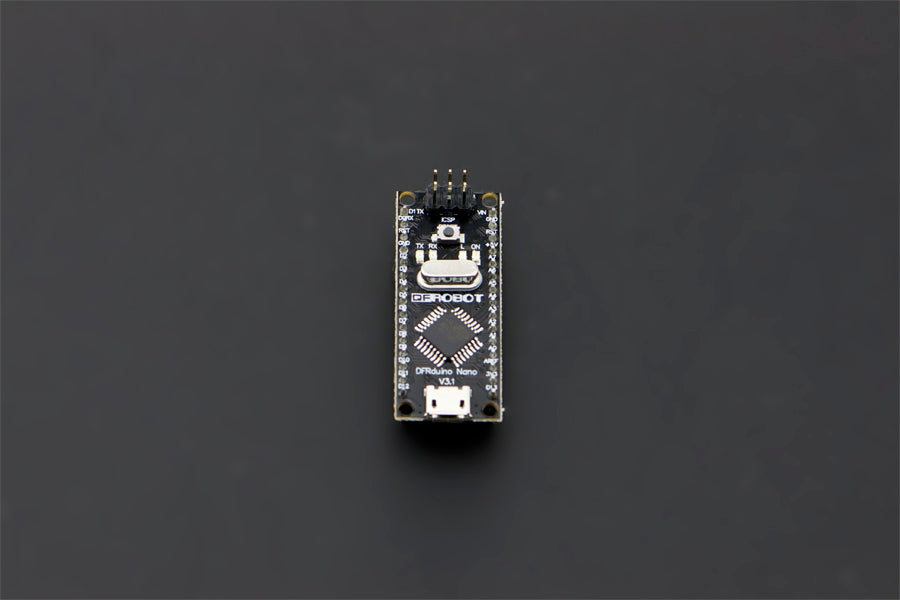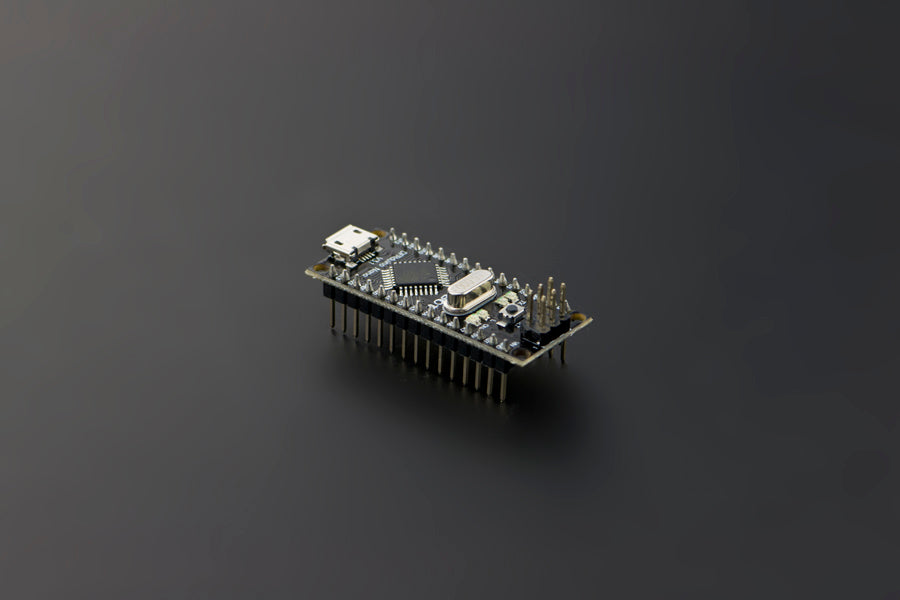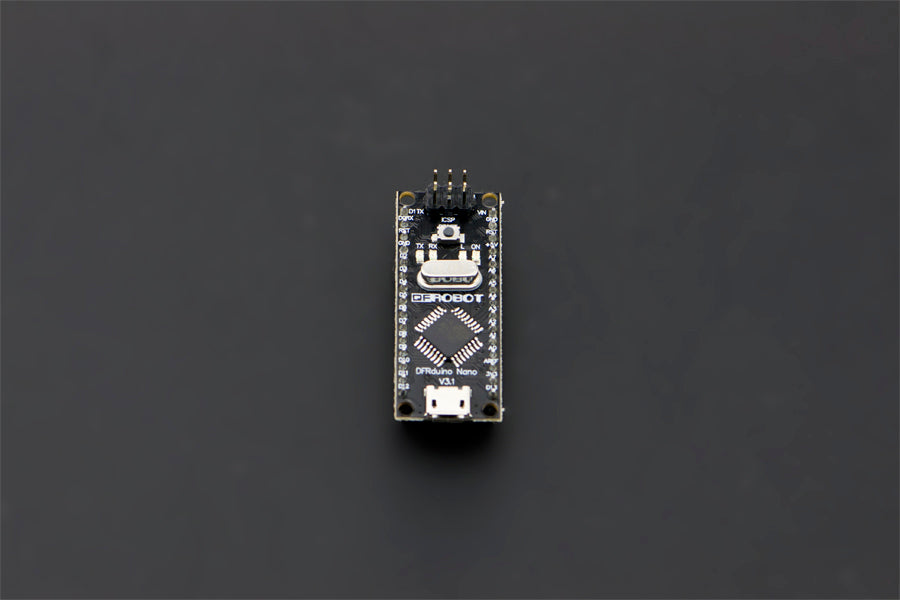Nano V3.1 by DFRobot Arduino Compatible - The Nano V3.1 by DFRobot Arduino Compatible is a breadboard-ready version of the Arduino mini with integrated USB. The Nano has everything that the Diecimila has (electronically) with more analog input pins and an onboard +5V AREF jumper. The Nano automatically senses and switches to the higher power supply, so there is no need for a power select jumper.
The nano's pin layout works well with the Mini or the Basic Stamp (TX, RX, ATN, GND on one top, power and ground on the other). The Arduino Nano V3.1 DFRobot USB Microcontroller V3.1 (ATMega 328) can be powered via the mini-B USB connection, 6-20V unregulated external power supply (pin 30), or 5V regulated external power supply (pin 27). The power source is automatically selected as the highest voltage source.
Power
The Mini-B USB port, a 6-20V unregulated external power supply (pin 30), or a 5V regulated external power supply are all options for powering the Arduino Nano (pin 27). The greatest voltage source is automatically chosen as the power supply.
Memory
The 32 KB of the ATmega328 include 2 KB for the boot loader. There are 2 KB of SRAM and 1 KB of EEPROM on the ATmega328..
Communication
A computer, another Arduino, or other microcontrollers can all be communicated with using the Arduino Nano's many communication features. UART TTL (5V) serial connection is provided by the ATmega328 and is accessible on digital pins 0 (RX) and 1. (TX). This serial connection is routed through USB by an FTDI FT232RL on the board, and the FTDI drivers (included with the Arduino software) give computer applications access to a virtual com port.
Simple textual data can be delivered to and received from the Arduino board using the serial monitor found in the Arduino software. When data is being communicated between the FTDI chip and USB connection to the computer, the RX and TX LEDs on the board will flash (but not for serial communication on pins 0 and 1). A program Any digital pin on the Nano can be used for serial communication thanks to the serial library.
Communication over I2C (TWI) and SPI is also supported by the ATmega328. To make using the I2C bus easier, the Arduino software comes with the Wire library. Consult the ATmega328 datasheet for information on how to use SPI communication.
Programming
The Arduino software can be used to programme the Arduino Nano (download). From the Tools > Board menu, select "ArduinoDuemilanove or Nano w/ ATmega328" (according to the microcontroller on your board). The bootloader on the preburned ATmega328 in the Arduino Nano enables you to upload new code to it without using an external hardware programmer. It uses the original STK500 protocol for communication. Additionally, you can use Arduino ISP or a similar device to bypass the bootloader and programme the microprocessor through the ICSP (In-Circuit Serial Programming) interface.
Automatic (Software) Reset
The Arduino Nano is made in such a way that software running on a linked computer can reset it without requiring a physical press of the reset button prior to an upload. A 100 nanofarad capacitor is used to connect one of the FT232RL's hardware flow control lines (DTR) to the ATmega328's reset line. The reset line lowers for a long enough period of time when this line is asserted (taken low) to reset the chip. By utilising this feature, the Arduino software enables you to upload code in the Arduino environment by just pressing the upload button.
As a result, the bootloader's timeout can be shortened because the upload's beginning and the lowering of DTR can be perfectly timed. This configuration has additional effects. The Nano resets each time a connection is made to it from software when it is attached to a computer running either Mac OS X or Linux (via USB). The bootloader is active on the Nano for the next half-second or so.
The initial few bytes of data transmitted to the board after a connection is established will be intercepted, despite the fact that it is configured to disregard invalid data (i.e., anything other than an upload of new code). Make sure that the software with which it talks waits a second after opening the connection and before transferring any configuration or other data when a sketch executing on the board receives it for the first time.
Version History
- v3.0 - improved the analog port pin mapping to be compatible with the original Arduino Nano
- v3.1 - changed the Mini USB port to a Micro USB port
FEATURES
- Automatic reset during program download
- Power OK blue LED on the bottom
- Green (TX), red (RX), and orange (L) LED
- +5V to AREF jumper
- Auto-sensing/switching power input
- Small mini-B USB for programming and serial monitor (cable not included)
- ICSP header for direct program downloads
- Power OK blue LED on the bottom
- Standard 0.1” spacing DIP (breadboard friendly)
- Manual reset switch
SPECIFICATION
- Microcontroller: Atmel Atmega328-20AU
- Operating Voltage (logic level): 5V
- Input Voltage (recommended): 7-12V
- Input Voltage (limits): 6-20V
- Digital I/O Pins: 14 (of which 6 provide PWM output)
- Analog Input Pins: 8
- DC Current per I/O Pin: 40 mA
- Flash Memory: 32 KB (of which 2KB used by bootloader)
- SRAM: 2 KB
- EEPROM: 1 KB
- Clock Speed: 16 MHz
Nano V3.1 by DFRobot Arduino Compatible
Nano V3.1 by DFRobot Arduino Compatible
Out of stock
Product Code
SKU:DFR0010
Couldn't load pickup availability
